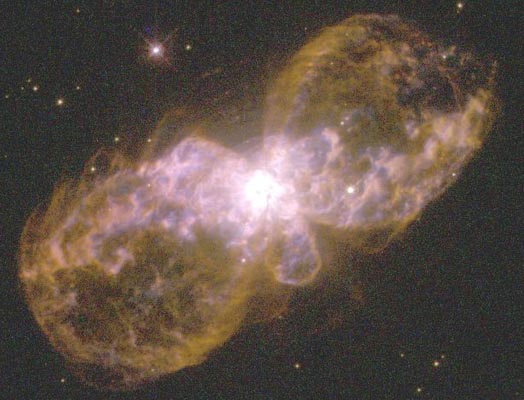Explanation: The Hubble Double Bubble Planetary Nebula is bubbling over with excitement. More mundanely known as Hubble 5, this bipolar planetary nebula is being created by a hot wind of particles streaming away from the central star system. The hot gas expands into the surrounding interstellar medium in a fashion similar to the inflation of hot air balloons. A supersonic shock-wave can form at the boundary, causing newly excited gas there to shine as electrons recombine with resident elements. In the above picture, colors are assigned according to the energy of the recombinant radiation. This star system lies about 2200 light-years from Earth, and likely includes a Sun-like star slowly transforming itself into a white dwarf.
1999 2000 2001 2002 2003 2004 2005 2006 2007 2008 2009 2010 2011 2012 2013 2014 2015 2016 2017 2018 2019 2020 2021 2022 2023 2024 2025 |
Yanvar' Fevral' Mart Aprel' Mai Iyun' Iyul' Avgust Sentyabr' Oktyabr' Noyabr' Dekabr' |
NASA Web Site Statements, Warnings, and Disclaimers
NASA Official: Jay Norris. Specific rights apply.
A service of: LHEA at NASA / GSFC
& Michigan Tech. U.
|
Publikacii s klyuchevymi slovami:
bipolar planetary nebula - Planetarnaya tumannost' - bipolyarnye vybrosy - belyi karlik - udarnye volny
Publikacii so slovami: bipolar planetary nebula - Planetarnaya tumannost' - bipolyarnye vybrosy - belyi karlik - udarnye volny | |
Sm. takzhe:
Vse publikacii na tu zhe temu >> | |
